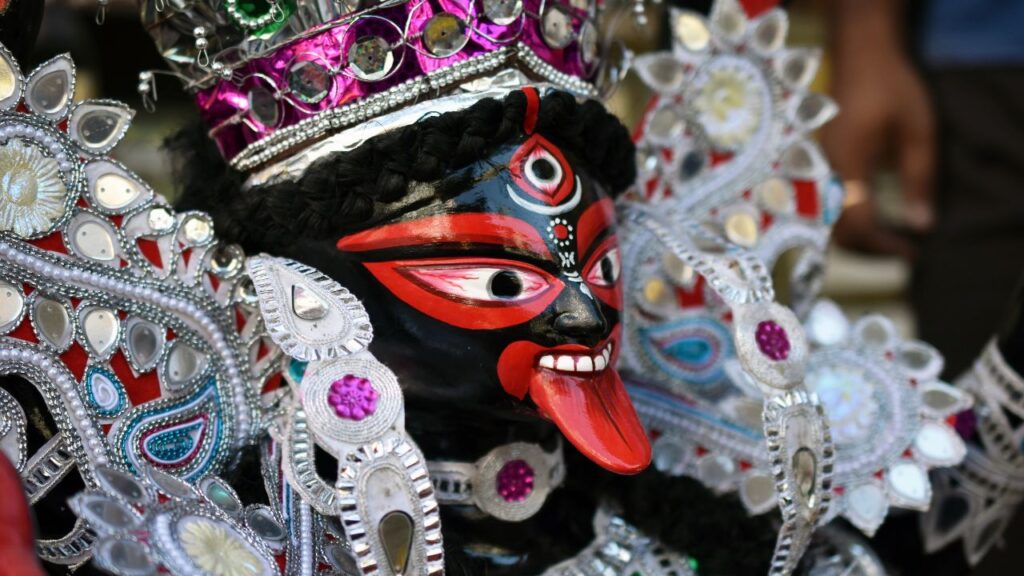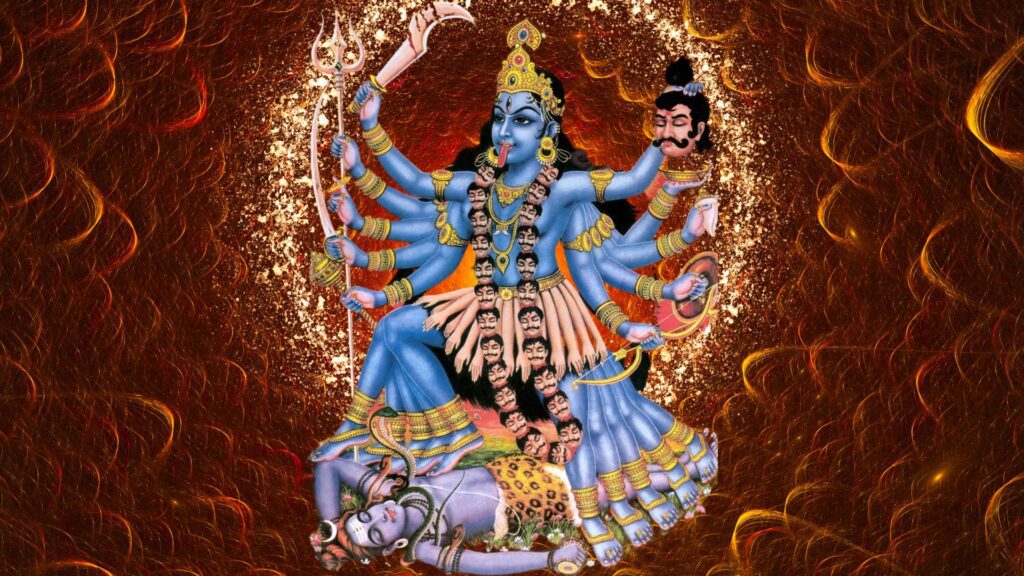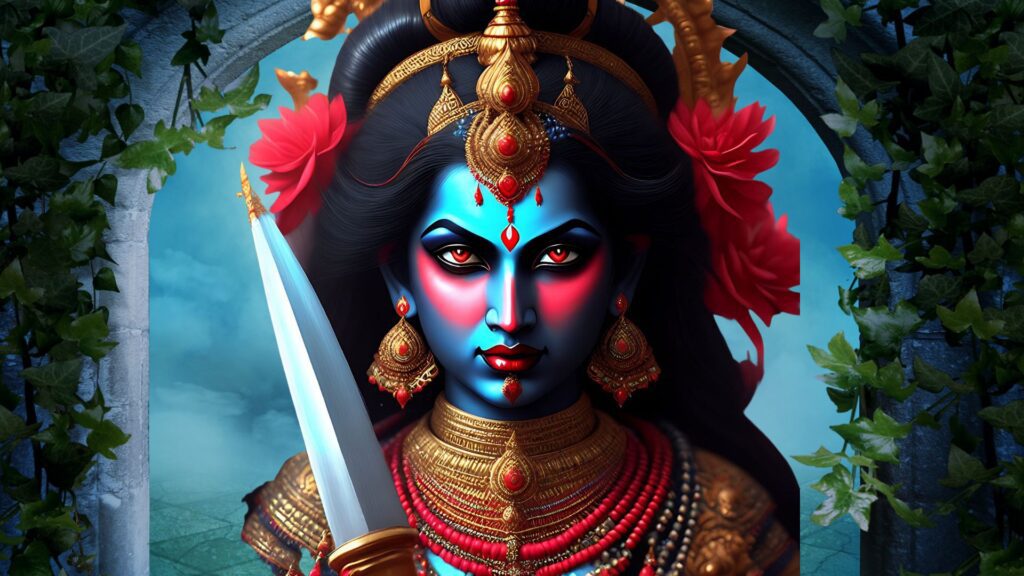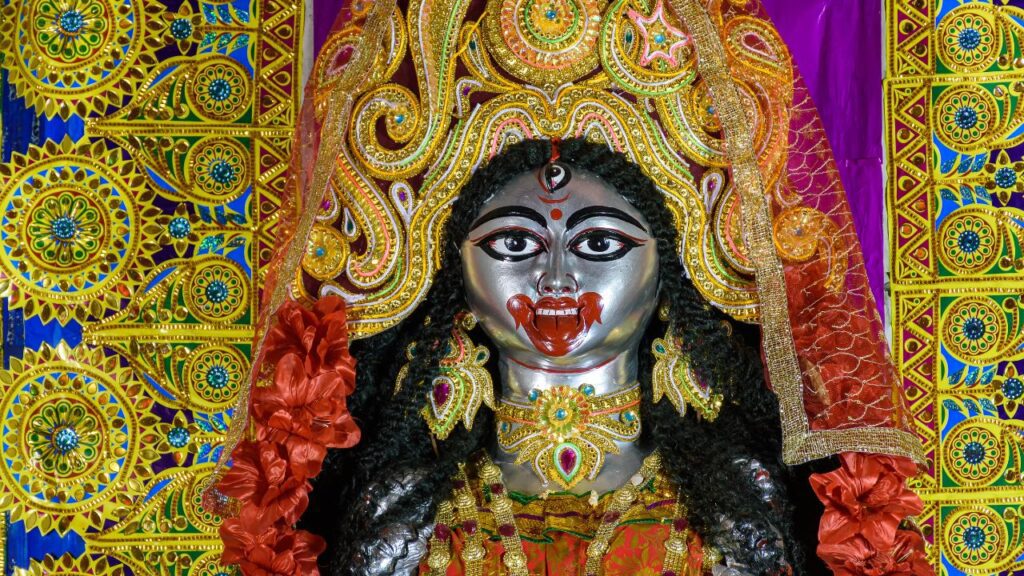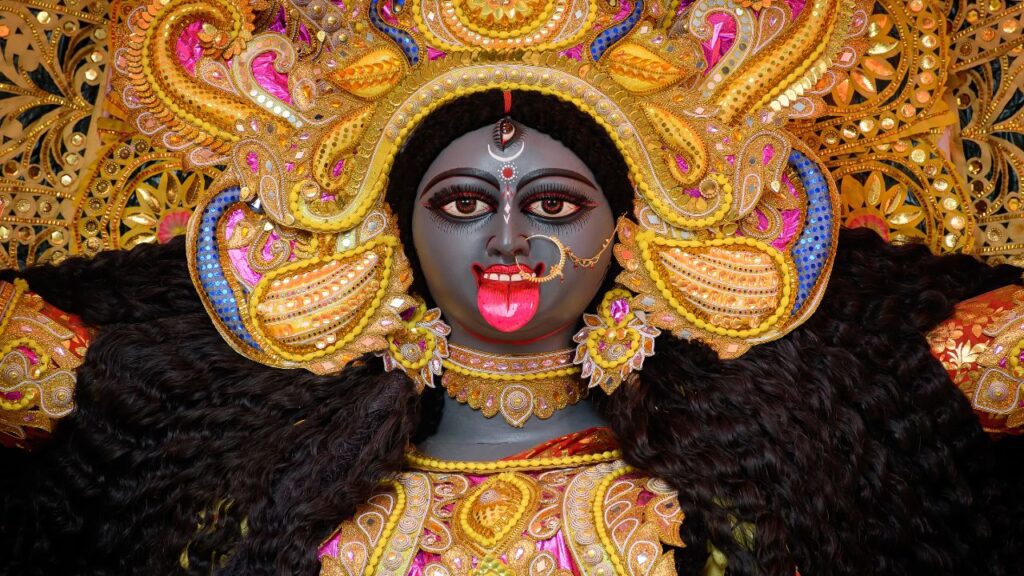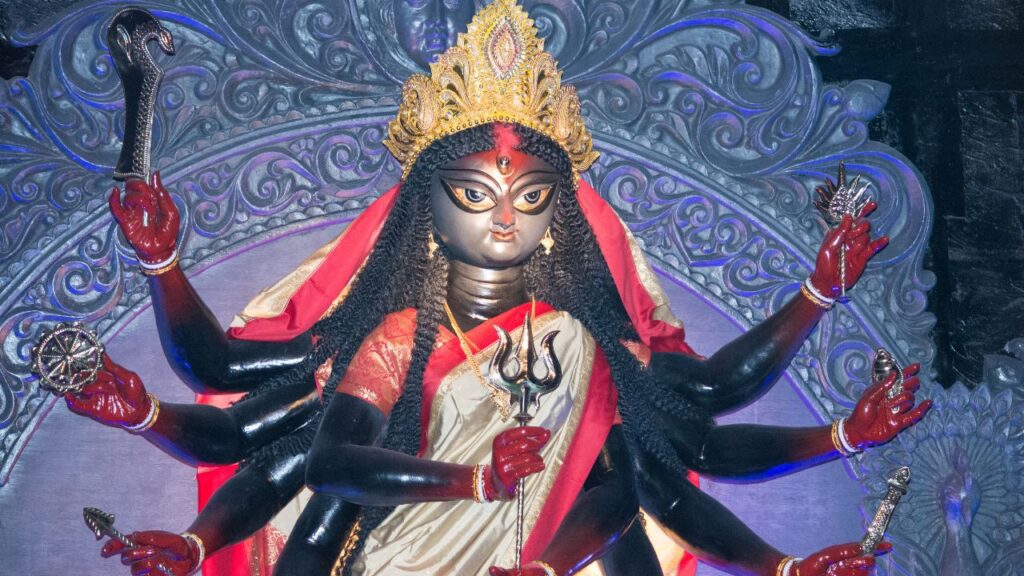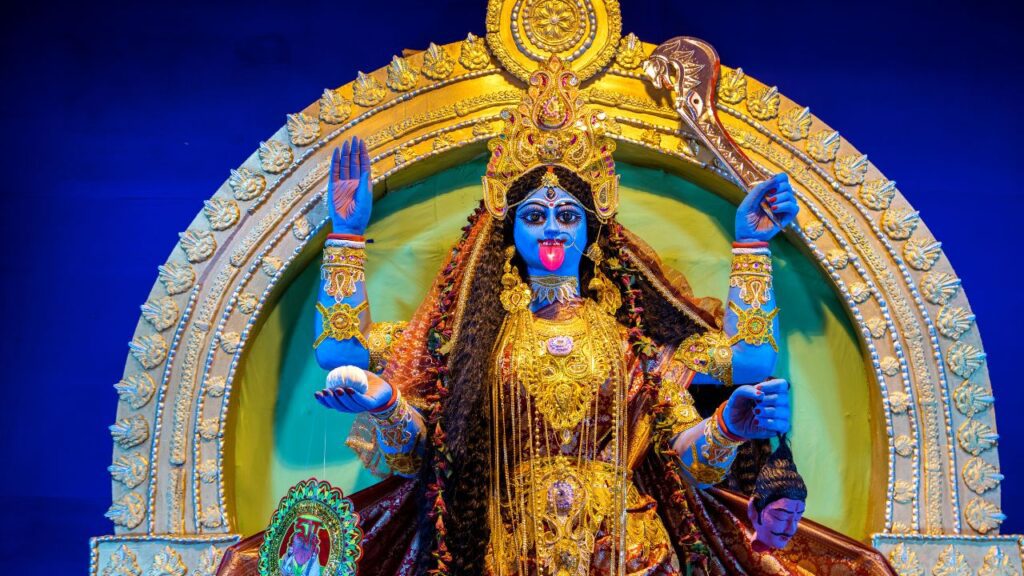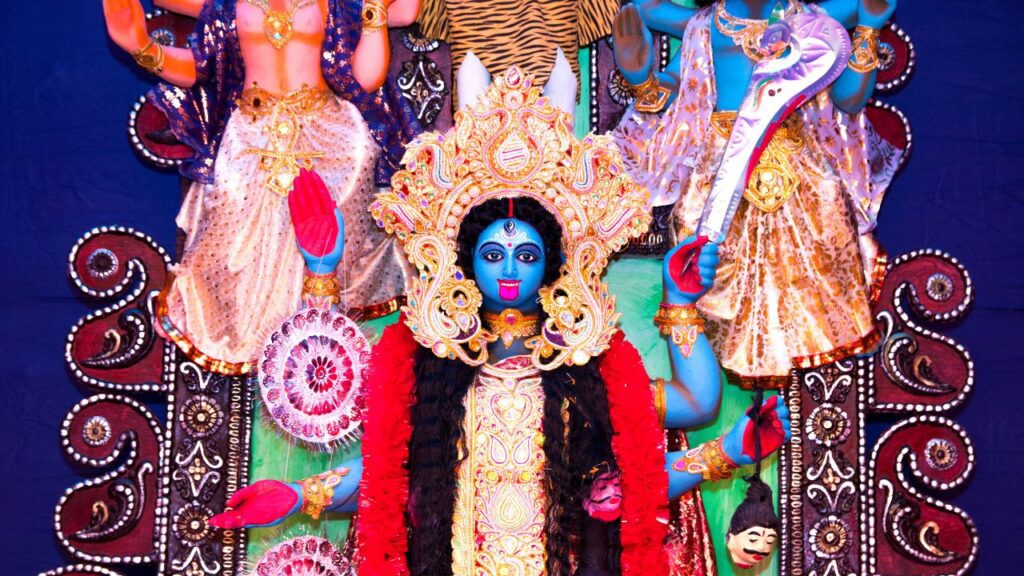Kali Symbolism: The Symbolism Behind Kaali’s Dark Skin
Introduction
The Hindu pantheon is a rich tapestry of heavenly feminine energy, every goddess reflecting different traits and attributes. Among them, Goddess Kali is a strong and multifarious goddess loved for her capacity to go beyond conventional beauty criteria. Her dark, nearly ebony skin is emblematic of the great secrets at the core of the world, not only a physical feature.
We shall investigate in this post the deeper meaning of Goddess Kali’s black skin and how it provides a channel for the most transforming and freeing elements of the divine feminine. We shall discover the great symbolism that makes Kali one of the most fascinating and misinterpreted deities in the Hindu faith from her beginnings and iconography to the great spiritual truths she gives.
The Cosmic Dance of Birth and Death and Reconstruction
Though these links reflect a far more complex and multifarious conception of her divine essence, Kali is sometimes connected with the ideas of death, destruction, and the disintegration of the ego. Her dark complexion reflects her position as the living example of the never-ending cycle of creation, preservation, and transformation, not only a personal preference.
The everlasting cycle of time
The Sanskrit word “Kala,” meaning “time,” forms Kali’s name. Her dark skin represents the limitless expanse of the cosmic emptiness, the primal source from which all manifestation originates and returns finally as the personification of time. Her ebony color stands for the infinite, always present blackness that precedes and covers the whole spectrum of creation, a timeless and always present truth transcending the illusion of linear time.
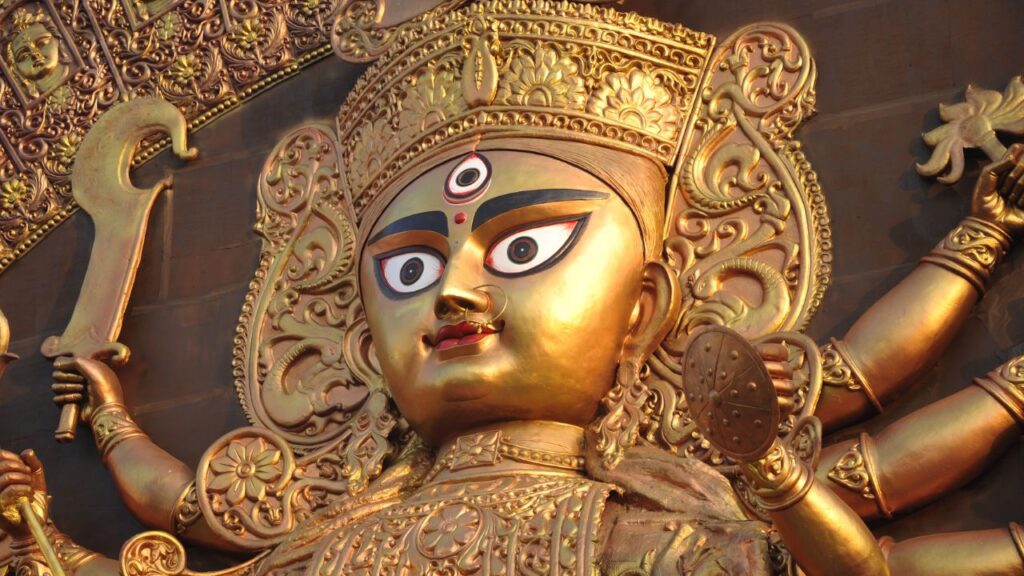
The Ego’s Disintegration
Many times, Kali’s ferocious and relentless nature is used as a metaphor for the erasing of the ego, the false sense of self that ties us to the cycle of attachment and misery. Her black skin symbolizes the final destruction of the narrow perspective of the individual, therefore enabling the devotee to submit to the infinite width of the divine feminine. The seeker can reach the freeing realization of their genuine, limitless nature by means of her grace, therefore transcending the boundaries of the physical world.
The Womb of Birth
Kali’s black skin also represents the primordial source from which all life arises—the rich womb of the universe. Her black skin reflects the fecund darkness of the cosmic matrix, the primal material spun from which the whole fabric of life is spun. Kali’s black complexion is thus evidence of the divine feminine’s ability to produce new forms, to nurture and sustain all of creation, and to finally reabsorb it back into the endless cycle of manifesting and disintegrating.
Kali’s Fierce and Compassionate Aspects
With her unkempt hair, projecting tongue, and garland of severed heads, Goddess Kali is sometimes portrayed as aggressive and even terrible. But this apparently graphic symbolism of her capacity to subvert the forces of ignorance, greed, and illusion that afflict the human situation represents very differently.
The Demonstrator of Destruction
Given Kali’s position as the vanquisher of demonic forces endangering the cosmic order, her black coloring and austere manner are sometimes linked. Hindu mythology holds that she sprang from the brow of the Goddess Durga to destroy the strong asuras (demons) that had been haunting the holy domains. Her black complexion and graphic images reflect her relentless will to eliminate the powers of evil and bring peace back into the planet.
The Mother with Compassionate Thoughts
Under Kali’s austere appearance sits the heart of a loving and caring mother. Her all-encompassing love and protection for her devotees—who she guides toward spiritual emancipation and ego dissolution—showcases in her black skin. Often shown in her benign, motherly forms, Kali’s unbounded compassion is seen when she blesses and feeds her children.
The Decipheration of Duality
Kali’s dual nature—that of the ferocious and the compassionate—represents the highest transcendence of dualism. Her black skin marks the unification of opposites, the reconciliation of the light and the dark, the masculine and the feminine, the divine and the human. By use of her grace, the devotee transcends binary thinking’s restrictions and welcomes the completeness of the divine feminine.
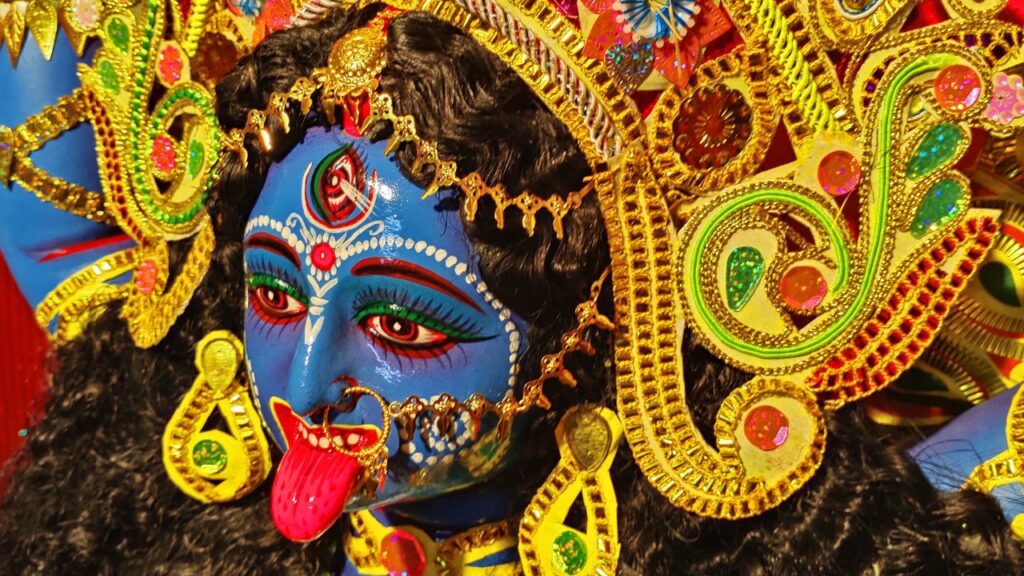
Goddess Kali’s Iconography
Goddess Kali’s visual images abound in meaning, and every component of her iconography reveals great spiritual insight. From her dark complexion to the goods she carries, every element of her portrayal reveals the most secret truths of the divine feminine.
The Negative Complexion
Kali’s dark complexion is indicative of the limitless, the absolute, and the primordial wellspring of all life as much as a physical attribute. Her black color is evidence of her function as the cosmic womb, the rich darkness from which all creation originates and returns finally.
The Garland of Scalks
Kali’s capacity to transcend the constraints of the physical world is powerfully symbolized by the garland of severed heads that hangs around her neck. The skulls stand for the ego—that illusory feeling of self that ties us to the cycle of birth and death. By donning this garland, Kali marks her victory over the illusion of uniqueness, therefore enabling the devotee to reach the liberating awareness of their actual, limitless nature.
The Sword and the Sevedered Head
Kali is sometimes shown with one hand wielding a sword and another carrying a recently removed head. The severed head stands for the elimination of the ego; the sword stands for the divine knowledge and wisdom that may cut the chains of ignorance. These iconographic devices taken together suggest that only the total annihilation of the finite, personal self can bring about actual emancipation.
The severed limbs
Sometimes Kali is shown sporting a skirt composed of chopped human limbs, an arresting image that suggests her capacity to go beyond accepted morals. These severed limbs allow the devotee to submit to the transforming force of the divine feminine, therefore releasing their attachment to the material world.
The protruding tongue
One of Kali’s most striking characteristics—her projecting tongue—is a potent emblem of her capacity to eat and absorb all of creation. This motion captures her function as the ultimate devourer, the power able to swallow the whole cosmos and restore it to the primal source. It is evidence of her control over the cycle of life and death as well as her ability to free the devotee from the bonds of earthly attachment.
The Worship of Goddess Kali
Deeply ingrained Hinduism is based on the respect of Goddess Kali, whose blessings and direction are sought for in all spheres of life. Her worship’s rites and ceremonies expose the great spiritual insights she shares with her adherents.
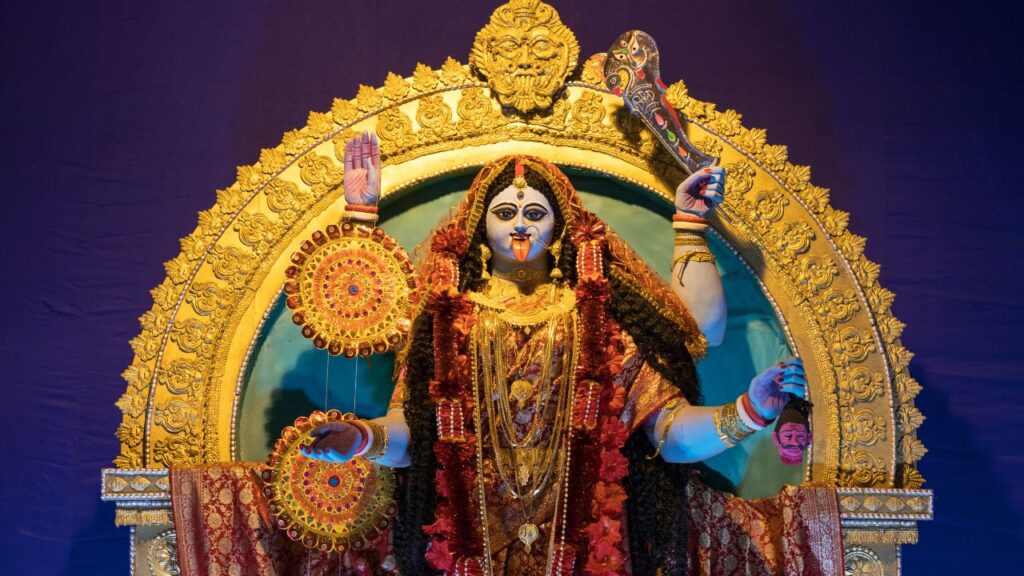
Kali Puja
Obsessed mainly in the eastern parts of India, especially in West Bengal, the Kali Puja is one of the most important festivities of Goddess Kali. Devotees come to respect the heavenly mother and seek her blessings for protection, wealth, and spiritual release at this festival. The rites sometimes call for presenting the deity with red hibiscus flowers, incense, and other symbolic objects.
Tantric Technique
Within the Tantric tradition, where she is considered as the incarnation of the ultimate reality and the source of all power, Goddess Kali is likewise much revered. Using Kali’s dark complexion as a symbolic depiction of the limitless and the absolute, Tantric practitioners perform many rites and meditations targeted at harnessing the transforming power of the divine feminine.
Chants and Devotional Songs
The rich custom of devotional songs and chants, sometimes known as bhajans and kirtans, also reflects the loyalty to Goddess Kali. These musical works honor the goddess’s multifarious character by stressing her ferocious and sympathetic sides as well as her function as the final liberator of the human spirit.
Site of Pilgrimages
India boasts many well-known pilgrimage sites honoring Goddess Kali, including the Dakshineswar Kali Temple in West Bengal and the Kalighat Temple in Kolkata. Devotees gather to seek the blessings of the dark mother and immerse themselves in the transforming force of her presence in these hallowed sites, which function as centers of spiritual practice and dedication.
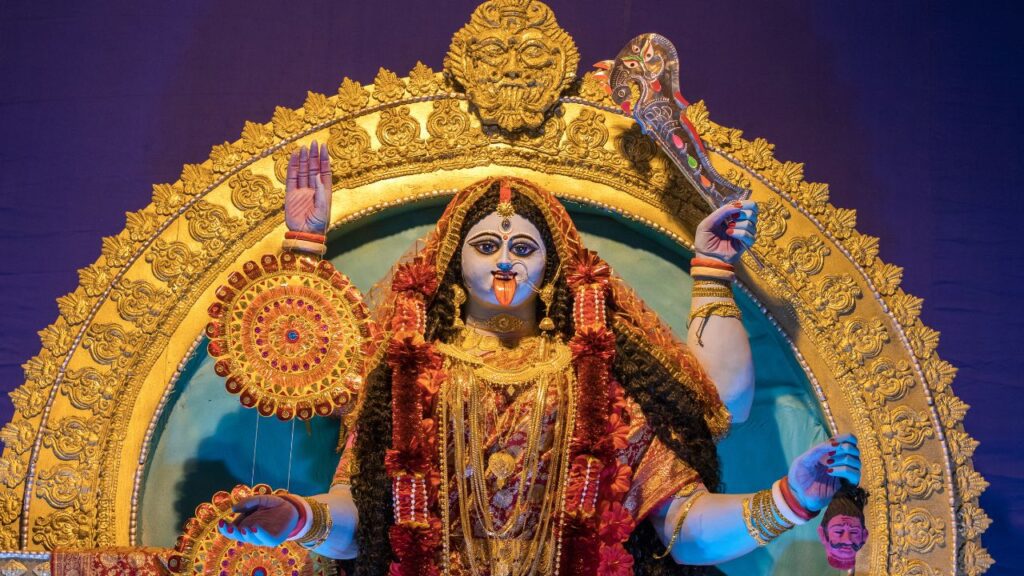
Kali’s Dark Skin: Symbolic Significance
The black complexion of Goddess Kali is a potent emblem that explores the deeper spheres of spiritual relevance and transcends outward looks. Her black color acts as a portal to the most transforming and freeing elements of the human experience, therefore reflecting the great secrets of the divine feminine.
The Primordial darkness
Kali’s dark complexion reflects the primal darkness, the limitless and everlasting wellspring from whence all creation arises. The goddess’s ebony skin reflects this cosmic womb, the rich nothingness that precedes and spans the whole spectrum of creation, calling the devotee to submit to the infinite stretches of the divine feminine.
The Ego Dissolves
With her black complexion, Kali’s strong and uncompromising quality serves as a metaphor for the damage of the ego, the false sense of self that ties us to the cycle of attachment and misery. Her ebony color stands for the ultimate annihilation of the limiting perspective of the individual, so enabling the devotee to go beyond the boundaries of the physical world and reach the freeing realization of their actual, limitless essence.
The Healing of Duality
The symbolic duality of Kali’s black complexion reflects her twin character—that of the fiery and the caring. Her ebony skin stands for the harmony of opposites, the healing of the light and the dark, the masculine and the feminine, the divine and the human. By use of her grace, the devotee transcends the confines of binary thinking and welcomes the totality of the divine feminine.
The Honor of Variability
Kali’s black complexion is a potent emblem of the embracing of variation by the divine feminine against limited beauty standards. Her iconography invites followers to celebrate the natural beauty and holiness of various skin tones and physical features, therefore subverting the conventional wisdom that says deity must be connected with a fair or light complexion.
The Changing Authority of Kali’s Devotion
Devotement to Goddess Kali allows the seeker to discover the depths of their own spiritual essence, therefore transcending the limits of the corporeal world. By means of the rites, ceremonies, and insights connected with her worship, followers might release the liberating power at the core of the divine feminine.
Getting Past Attachments and Anxiety
Many times, Kali’s strong and relentless nature is considered as a means of facing and conquering the attachments, worries, and concerns afflicting the human condition brings. The devotee can release the bonds of the ego and embrace the limitless breadth of the divine feminine by turning to her transforming power, therefore realizing their actual, infinite nature.
Encouragement of Empathy and Authority
Furthermore encouraging the growth of compassion and empowerment inside the devotee is the respect of Goddess Kali. Her black skin, which stands for the infinite compassion and protection of the divine mother, motivates the seeker to develop a caring and inclusive viewpoint toward all beings, therefore transcending the boundaries of personal identification and accepting the connectivity of all creation.
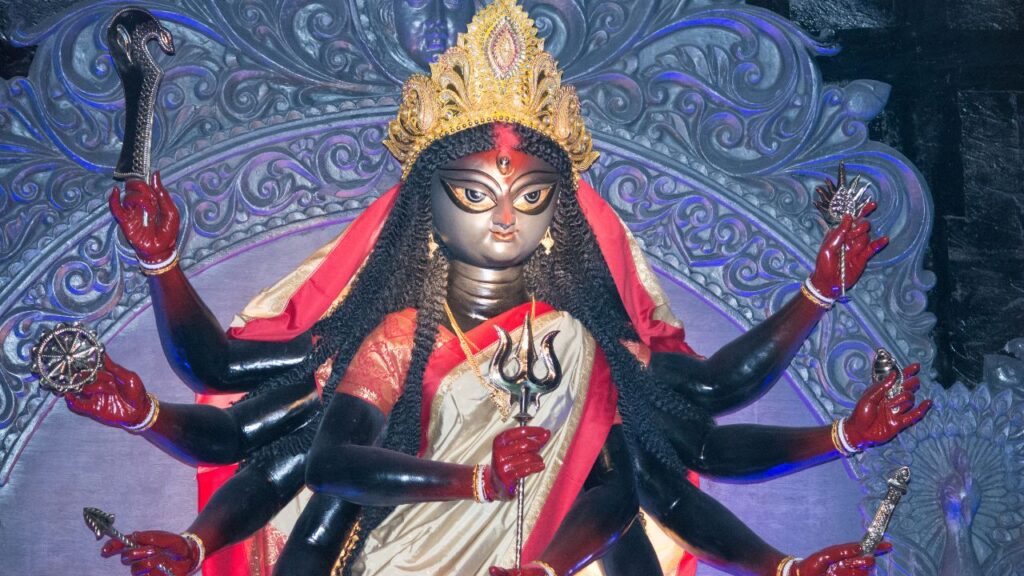
Opening the Secrets of the Universe
By means of the rites and ceremonies connected with Kali’s worship, followers can uncover the great secrets of the universe, therefore exploring the primordial darkness both before and across all manifestation. Through this path of self-discovery, the seeker can connect with the timeless rhythms of the divine feminine and go beyond the limits of the earthly.
Reaching Spiritual emancipation
In the end, the dedication to Goddess Kali is a road towards spiritual emancipation, a method to get beyond the cycle of life and death and reach the awareness of one’s own, limitless character. Her black complexion is a potent emblem of the transforming power at the core of the divine feminine since it stands for the disintegration of the ego and the unification of all opposites.
Conclusion
The dark skin of Goddess Kali is a great and multifarious emblem that urges the follower to investigate the most profound secrets of the divine feminine. Her black skin provides a channel for the most transforming and freeing elements of the human experience from the primordial darkness of creation to the terrible annihilation of the ego.
Accepting the symbolic meaning of Kali’s dark complexion will help us to accept the inherent holiness of all physical characteristics and go beyond the constraints of traditional beauty criteria. By means of connecting ourselves with the universal rhythms and realizing our actual, limitless essence, we can also release the transforming potential of the divine feminine.
Ultimately, the commitment to Goddess Kali is a road of self-discovery that brings us to the very center of the divine and encourages us to welcome the infinite love, compassion, and empowerment at the core of the human experience. It is a call to release the ego’s chains and welcome the transforming power everyone possesses.
#kali #symbol #symbolism #maakali
